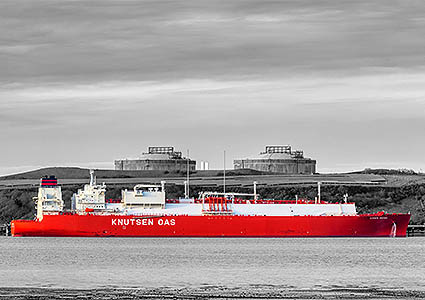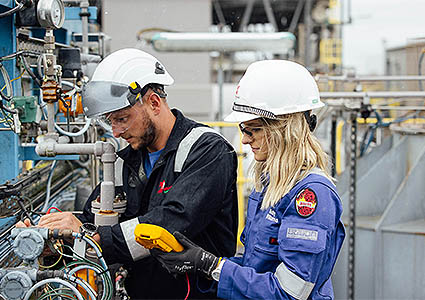Decarbonizing the energy sector: Dragon LNG leads the way with innovative sustainability initiatives
Established as a standalone business, Dragon LNG Ltd (Dragon) owns and operates a Liquefied Natural Gas (LNG) import and storage terminal in Milford Haven, West Wales.
Dragon is jointly financed by two industry shareholders: Shell UK, and Ancala LNG Ltd, who is in the process of selling its share to a new co-owner, VTTI. Each entity owns 50 percent of the issued share capital. Dragon’s LNG terminal boasts an excellent safety record, providing a reliable and flexible supply of natural gas to homes and businesses across the UK, and ensuring long-term energy security. Today, we sit down for an exclusive interview with Simon Ames, Managing Director, to learn more about the company.
 “Initially founded as one of three LNG regasification terminals for the UK, Dragon was built in the 2000s, commissioned in 2009 and has completed 15 years of safe, successful commercial operations. We are responsible for approximately ten percent of the UK’s energy needs, which also includes gas supplies to Europe through pipelines in the North Sea. This proportion is expected to remain consistent for the next couple of decades. At Dragon, we are currently undergoing a regulated third-party access auction, with the result being that next year, our terminal may have either the same customers or new customers, depending on who wins the auction process.”
“Initially founded as one of three LNG regasification terminals for the UK, Dragon was built in the 2000s, commissioned in 2009 and has completed 15 years of safe, successful commercial operations. We are responsible for approximately ten percent of the UK’s energy needs, which also includes gas supplies to Europe through pipelines in the North Sea. This proportion is expected to remain consistent for the next couple of decades. At Dragon, we are currently undergoing a regulated third-party access auction, with the result being that next year, our terminal may have either the same customers or new customers, depending on who wins the auction process.”
Sustainable solutions
Renewables are another core part of the business, notes Simon, as Dragon operates a renewables park through its Dragon Energy division. “This park consists of 18,500 solar panels, generating approximately ten megawatts. Furthermore, Dragon is in the planning phase with the Welsh Government to build wind turbines, while looking to potentially incorporate batteries further down the line, as well as a solar expansion. One of the company’s primary objectives is to achieve sectoral decarbonization in Milford Haven as well as that of its LNG facilities. To achieve this, Dragon works closely with the government and other industry partners to assess and implement sustainable solutions,” he continues.
In line with its commitment to decarbonization and sustainable energy solutions, Dragon has forged a significant partnership with German multinational energy company, RWE. “This collaboration is crucial due to our close proximity to RWE’s power station, which relies on our gas to fuel its gas turbines. Since RWE produces a significant amount of CO2, we are actively exploring a joint project whereby Dragon would not only provide them with natural gas but also liquefy and transport their CO2 to sequestration sites in the North Sea via specialized CO2 ships. Beyond the vital role it would play within our terminal’s mission to ensure energy security in the UK, this initiative would also contribute substantially to our decarbonization goals in Milford Haven.
Enhanced operations
“As part of this partnership, we are currently in feasibility discussions, looking at the potential to integrate CO2 liquefaction plants together with an LNG regasification and reliquefication plant, a brand-new concept in the industry. Through heat exchangers, we are going to mix the warm CO2 and the cold LNG, transferring the cold from the LNG to the warm CO2 and the warmth of the CO2 to the cold LNG. Consequently, we are regasifying the LNG and liquefying the CO2, thereby creating an amazing efficiency rather than building separate plants for each process. Moreover, this enables us to get free energy operationally through that heat exchange,” Simon explains.
Moving forward, Simon provides valuable insights into Dragon’s operations at its LNG terminal, giving us a clear understanding of the processes involved. “Before the gas is distributed into the National Grid to meet our customers’ requirements of supplying gas to consumers, the LNG arrives at the Dragon jetty by extremely large carrier ships, some of which can contain over 200,000 cubic meters of LNG. As these ships dock at our jetty, our unloading arms extract the LNG from the ship to our two 160,000 cubic-meter storage tanks (each are large enough to effortlessly encapsulate the Royal Albert Hall). When our customers nominate ‘send out’ of the gas, the -1600c LNG leaves the tanks and flows through the submerged combustion vaporizers (essentially big baths of warm water) where the liquid is converted into a gaseous state expanding its volume by 600 times, a process known as regasification.”
Potential processes
Although LNG is hailed as the cleanest of the fossil fuels, its production still contributes to carbon emissions. Simon sheds light on the initiatives undertaken by Dragon to enhance the sustainability of its operations. “At Dragon, our overarching goal is for our LNG terminal to achieve Net Zero, beginning with the reduction of our Scope 1 and 2 emissions. To that end, we are closely working with RWE’s power station on potential heat integration options, and future carbon capture processes they might undertake.
Dragon to enhance the sustainability of its operations. “At Dragon, our overarching goal is for our LNG terminal to achieve Net Zero, beginning with the reduction of our Scope 1 and 2 emissions. To that end, we are closely working with RWE’s power station on potential heat integration options, and future carbon capture processes they might undertake.
“Furthermore, we are dedicated to significantly reducing our Scope 2 emissions. Indeed, we are conducting feasibility studies on a broad array of heat integration options that could possibly replace the gas used for LNG regasification. Additionally, to lower our electricity usage, we harness the power of Dragon Energy’s 18,500 solar panels, which I mentioned earlier. On a sunny day, these panels empower us to produce ten megawatts. With the wind turbines we plan to install next year, we will be able to generate an additional 15 megawatts of renewable energy. Battery storage is also being considered as part of our long-term strategy. Together, these initiatives make a significant contribution to reducing our Scope 2 emissions as we strive towards achieving Net Zero,” he adds.
Taking this a step further, Dragon is also actively tackling Scope 3 emissions, which results from activities throughout the entire value chain beyond its direct control. Simon provides us with a better understanding of what these emissions entail and how Dragon addresses them: “If we supply gas to a power station, then that power station considers it as their Scope 1 emissions, but for us, it falls under Scope 3 emissions. In essence, our Scope 3 emissions are generated when our customers burn our LNG in their industrial sites, homes, etc. At Dragon, we have several initiatives in place to reduce these Scope 3 emissions. For instance, if RWE capture their CO2 and return it to us through a pipeline, we can liquify it and ship it off to sequestration sites. Thus, if all of RWE’s gas turbines were equipped with carbon capture technology and we caught all that CO2, it would effectively reduce our Scope 3 emissions to zero. These advancements mark an exciting era for sectorial decarbonisation and our operations at Dragon,” he ends.
By continuously coming up with ingenious ideas to enhance the environmental friendliness of the energy industry, such as integrating CO2 capture with RWE, Dragon is poised to drastically reduce emissions both internally and externally, within the South Wales Industrial Cluster and Milford Haven. Through groundbreaking heat exchange technologies and innovative industry collaboration models, the company plays a crucial role in shaping a more sustainable future.
